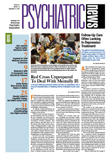Mania that is secondary to HIV infection appears to be distinct from primary mania in patients without HIV infection. And among patients with HIV-related secondary mania at two Ugandan hospitals, the presentation of mania was correlated with lower CD4 counts. That finding suggests that secondary mania can be a marker for the initiation of antiretroviral therapy, according to a report that appeared in the August American Journal of Psychiatry.
“Primary mania and HIV-related secondary mania are clinically and immunologically distinct,” wrote lead author Etheldreda Nakimuli-Mpungu, M.B.Ch.B., M.Med., and colleagues. “The relation between secondary mania and depressed CD4 counts suggests that in the setting of an HIV/AIDS epidemic in poor countries, secondary mania may be used as an indicator to initiate highly active antiretroviral therapy.”
The author is with the departments of psychiatry and medicine at Makerere University in Kampala, Uganda.
In the study, the authors compared HIV-negative and HIV-positive patients admitted to psychiatric wards with acute mania on psychiatric, physical, immunological, and other laboratory parameters.
Primary mania was diagnosed if a patient met DSM-IV criteria for bipolar disorder in the manic phase and was HIV negative. Secondary mania was diagnosed if the patient was HIV positive and had no clear personal or family history of mood disorders.
“Although the criteria of a close temporal proximity of an organic insult to the brain and the subsequent mania as well as late age of onset are often used in defining secondary mania, in the case of HIV-related mania... these criteria cannot always be applied because of the prolonged course of HIV infection and the high rate of infection in relatively young people,” the investigators stated.
Of 141 patients who presented with acute mania during a six-month period and were eligible for the study, 61 met criteria for HIV-related secondary mania because of a lack of any personal or family history of mood disorders. Sixteen HIV-positive patients were considered to have a possible primary mania coexisting with HIV infection because of a personal or family history of mood disorders and hence were excluded from data analysis.
The other 64 patients were HIV negative and therefore considered to have primary mania. Compared with HIV-negative patients with primary mania, they were older, more cognitively impaired, less educated, and morelikely to be female. They also had more manic symptoms: they were more irritable, more aggressive, and more talkative andhad higher rates of paranoid delusions, visual hallucinations, and auditory hallucinations.
More of the HIV-positive secondary mania group had CD4 counts below 350 cells/mm.
The authors noted that researchers have postulated secondary mania in the late stages of HIV illness may be linked to HIV infection of the brain.
In an accompanying editorial, robert G. robinson, M.D., wrote that the hypothesis is consistent with findings that antiretroviral drugs that penetrate the blood-brain barrier may be protectiveagainst secondary mania in persons with HIV infection.
“These findings demonstrate that first-episode mania in Ugandans well into adulthood is predictive of AIDS and are consistent with the hypothesis that HIV infection of the brain leads to the development of secondary mania,” robinson wrote. “Careful attention to nuances in the presentation of psychiatric illnesses, such as the Ugandan psychiatrists' observation of first-episode mania occurring in adults who were older and more psychotic than expected for a first episode, can indicate the presence of other illnesses.”
He is with the Department of Psychiatry at the University of iowa and has been a consultant for avanir Pharmaceuticalsand Hamilton Pharmaceuticals.
The study was funded in part by the Ministry of Health Support to the Health Sector Strategic Plan Project, which is funded by the african Development Bank; Makerere University Faculty of Medicine; and an APA/astrazeneca young Minds in Psychiatry international award to lead author nakimuli-Mpungu.
